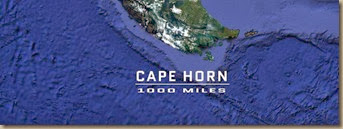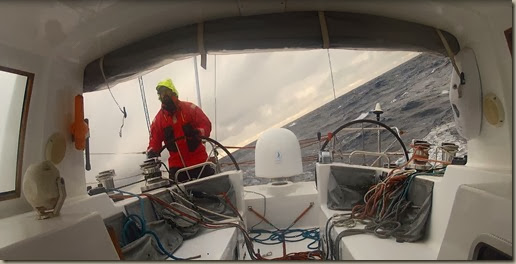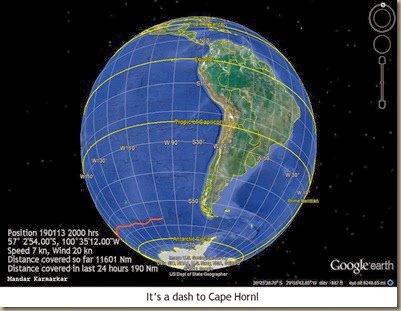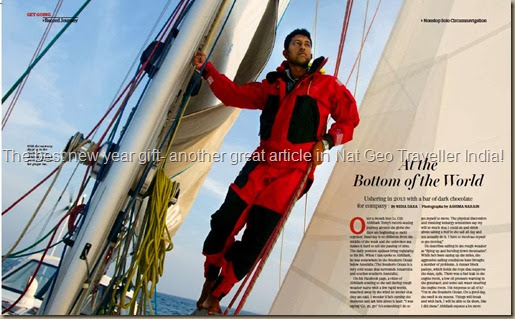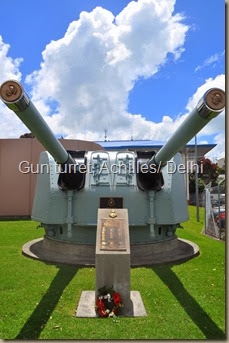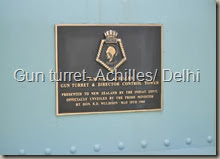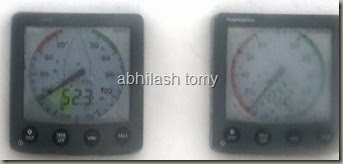 |
| A representation of the Horn- Urmimala |
"The geography of the sailor is not always the one of the cartographer, for whom a cape is a cape with its longitude and latitude. For the sailor, a great cape is both very simple and extremely complex, with rocks, currents, furling seas, beautiful oceans, good winds and gusts, moments of happiness and of fright, fatigue, dreams, aching hands, an empty stomach, marvelous minutes and sometimes suffering. A great cape, for us, cannot be translated only into a latitude and a longitude. A great cape has a soul, with shadows and colors, very soft, very violent. A soul as smooth as that of a child, as hard as that of a criminal
~~Bernard Moitessier~~~
Sometime in September last year when I was asked to finalise the exact dates of passing cardinal marks, 26th of January seemed a possible date for the rounding of the Horn. But as any yachtsman would know, sticking to the exact ETA at the end of almost three months in a wind driven boat is a task that is next to impossible. The Mhadei, however, would have it no other way and after crossing the International Date Line on the last day of last year, she decided to round the Horn on the Aquarian date of the 64th anniversary of the Republic Day of India, the 225th Australia Day and the 35th wedding anniversary of my parents. At 01: 45 PM in India and 03:15 on the deck watch, the Mhadei carried me across the longitude of Cape Horn twenty miles to its south marking the end of our passage through the Pacific, through the Chilean SRR, and of Leg Three and crossed us over to the Atlantic, into Argentina’s SRR and into Leg Four of the voyage. A moment later I hoisted the national flag on the backstay which was followed by the flypast of albatrosses and cormorants and a steam-past of smiling dolphins. The flag was a happy flag to be fluttering free in fresh breeze so far away from mainland India and its colours contrasted well with the dark shades of the sea and sky. The waves literally chanted lines from the national anthem- उच्छल जलधि तरंग (chanted by the waves of the Ocean).
 |
| Flying the Flag- a mile south of Cape Horn |
A little after crossing the longitude and the flag hoist, I gybed and headed towards Cape Horn for a closer look and I went as close as a mile and a half. But it lifted its veil of fog and low clouds only briefly- enough for a glance but not enough to make a good picture. The Horn wanted it to be a moment shared only between the two of us, I presume. In that instant, the Cape spoke to me through the words of Lynn
My name is Horn
Come shake my hand
And say hello to me
I welcome all who pass me by
With open arms and stand
Because I know they must do it
Because I know they can
Do not fear me
Drink deeply from the waters
That lap across my feet
Your thirst is quite unquenchable
Your spirit incomplete
My name is Horn
Come take my hand
And let me cool your heat
Do not hide from me
Drape a shawl across my back
The one with colours three
The breeze will catch its gentle flow
To set those demons free
My name is Horn
Come hold my hand
And rest a while with me
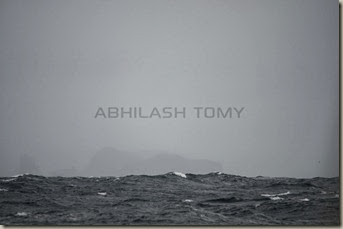 |
| The Horn behind a veil of fog and clouds |
More celebrations were in tow – DFRL helped me prepare kheer and a packet of biryani for lunch which are luxuries given the fact that I have been out at sea for so long and considering the circumstances I am accustomed to now. In keeping with my promise, a bottle of Desmond Ji agave was opened and the Sea of Hoces was offered a generous swig which immediately seemed to soothe its nerves and calm its waves. The next swig went to the boat and the rest was equally divided amongst all crew that mustered on deck. Offended at not being offered anything the Horn tore the genoa and claimed a camera when the boat crash gybed and the main sheet entangled with a Go Pro.
Once the ceremonials were dispensed with, I made calls to the three men who had conned me into undertaking this voyage with their boisterous talk, many tales and assurances- the godfather, Admiral Awati, the mentor. Cdr Donde and the boatbuilder, Ratnakar Dandekar- and congratulated them because each one of them is party to this successful rounding many times more than I am. Admiral Awati had a verse ready for the occasion
Ayyo, Tharavad of Valliara in the country of the Gods
Thy scion Abhilash sails MHADEI fair, over seas seven
Across the tempestuous ocean nether, from West to East
Past the great Capes
To conquer watery space
Of our Earth
To the greater glory of Bharat.
On the day we proclaimed a Republic, good and free
Twenty sixth of January two thousand one three
MHADEI and Man will pass the Horn
Many a gallant sailors nemesis and thorn
And show the flag to the rock and albatross
To say that Abhilash was there that day in
Celebration of a nation expectant
Of greater glory upon the seas, at the Horn
Eastward Ho! to Hope, the last, final mark
Before turning north into the Ocean Indian
And home to where it all began
On prime November the year before
Twelve and two thousand to complete
His tryst with destiny.
He, Abhilash, will then seek the blessings
Of the Almighty in the Tharavad
Of Valliara. So be it, says I who started it all.
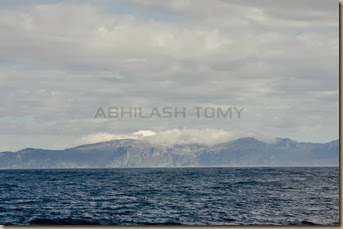 |
| Isla de los Estados |
The weather cleared by next day and I woke up in the Atlantic to bright sunshine, rising warmth and a craggy island lying supine to the port as if it was consolation for not sighting the Horn. The charts called it the Isla de los Estados and placed it in Argentina. On the other side of the horizon I made out a mast and I quickly called her on the radio to find out that she was called the Erica XII and that they were on their way from Ushuaia to Antarctica. The voice on the radio was that of a woman and listening to one after 88 days at sea reminded me of the aroma of fresh food, clean cotton linen and warm heated floors.
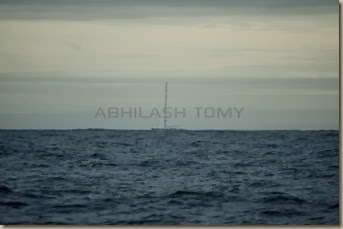 |
| Erica XII |
That is the story of how I rounded the Horn and became a Cape Horner. I will not have a medal on my chest to show for it, but you will know me because in keeping with the ancient traditions of mariners I will wear a ring of gold on my left ear ( a very special someone has already bought one) and keep my feet on the dining table during every meal.
Up Next- The Third crossing of the South Atlantic.
PS. Many people mistake the rounding to be the most difficult part of a voyage and liken it to the Everest of sailing but it is not so. It is never about the moment of rounding or the moment of sighting but the rounding itself is a significant milestone in years of effort and toil and at times a euphemism for it.
In the meantime a brave set of women adventurers from the Indian Army climbed the Mt Everest- the Cape Horn of every mountaineer. Many congratulations!





